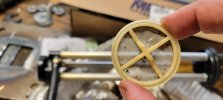Urban Digger
New Member
This is a great forum. The information here has helped me fix a lot of problems over the past few years.
A few years ago, we picked up a 2008 CAT 301.8C to do some projects around the property. When I got it, it had low power and would stall. We replaced all the fuel lines and filters and put in a new lift pump. When we did this the screen at the bottom of the fuel pick up in the tank was clogged and we cleaned it.
After that everything worked fine for over a year and about a hundred hours on it. The problem came back. We found the screen was clogged again, cleaned it, repeat. We did this a couple of times and it was no big deal for a yearly task.
Now the screen in the tank clogs after about a half hour of use. Whatever was in the tank that would make its way to the fuel pick-up over time broke loose and is now floating around in the tank and a big headache. It looks like mud.
What’s the best way to clean the tank without removing it from the chassis? If there is a drain plug, we did not find it. The only access into the tank appears to be from the top where the fuel pick-up mounts.
Any help or pointers would be appreciated.
A few years ago, we picked up a 2008 CAT 301.8C to do some projects around the property. When I got it, it had low power and would stall. We replaced all the fuel lines and filters and put in a new lift pump. When we did this the screen at the bottom of the fuel pick up in the tank was clogged and we cleaned it.
After that everything worked fine for over a year and about a hundred hours on it. The problem came back. We found the screen was clogged again, cleaned it, repeat. We did this a couple of times and it was no big deal for a yearly task.
Now the screen in the tank clogs after about a half hour of use. Whatever was in the tank that would make its way to the fuel pick-up over time broke loose and is now floating around in the tank and a big headache. It looks like mud.
What’s the best way to clean the tank without removing it from the chassis? If there is a drain plug, we did not find it. The only access into the tank appears to be from the top where the fuel pick-up mounts.
Any help or pointers would be appreciated.




